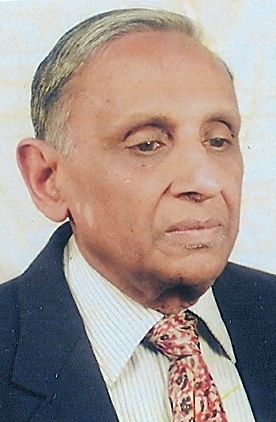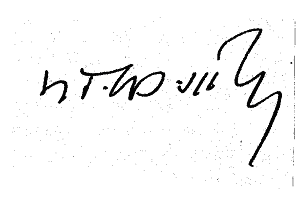Latest Contributions
Read More Contributions
Mahatma Gandhi’s Last Autograph? by R C Mody
Category:

R C Mody is a postgraduate in Economics and a Certificated Associate of the Indian Institute of Bankers. He studied at Raj Rishi College (Alwar), Agra College (Agra), and Forman Christian College (Lahore). For over 35 years, he worked for the Reserve Bank of India, where he headed several all-India departments, and was also Principal of the Staff College. Now 81 years old, he is busy in social work, reading, writing, and travelling. He lives in New Delhi with his wife.
In January 1948, I was living in Alwar, now a part of Rajasthan, which at that time was a quasi-independent Princely State – the Maharaja had signed the Instrument of Accession, but not the Instrument of Merger. Alwar had more than its normal share of the post-Partition riots and unrest, which, for months, had disrupted rail travel to and from Delhi, a distance of about one hundred miles.
I needed to go to Delhi urgently, but had to wait until I could get a seat in a Government vehicle going there – the only safe way to travel. I managed to get to Delhi on January 28th.
In Delhi, I attended Mahatma Gandhi’s prayer meeting at the Birla House on the evening of January 29th. I left there my autograph book there for the Mahatma's signature, for which I had to pay his prescribed fee was Rs. 5 for his Harijan Fund. Next morning, on January 30th, I returned to Birla House and collected my book, which now had his valuable signature.
My work in Delhi was finished during the course of that day, and now I faced the problem of getting a ride back Alwar. The focal point of Government vehicles to and from Alwar was the New Delhi residence of Dr N. B. Khare, who was then the Prime Minister of Alwar State. His house on Canning Road had been allotted to him by the Government of India in his capacity as a member of the Indian Constituent Assembly, nominated by the Maharaja of Alwar. The Constituent Assembly was preparing India’s Constitution, and also functioning as the nation’s provisional Parliament.
I went to Dr Khare’s home at around 5.00 pm to find out if I could get a lift back to Alwar the next day. While there, willy-nilly, I got pushed into the room in which Dr Khare, just back from a meeting of the Constituent Assembly, was lecturing a group of visitors. I realised that they were all his “Yes men”, listening reverentially to whatever their VIP host had to say. That evening, as at many other times, Dr Khare was virulently attacking Mahatma Gandhi and Jawaharlal Nehru, India’s Prime Minister, because he felt that they and their policies had betrayed Hindus.
Soon after I entered the room, the phone rang, and the caller insisted on talking to Dr Khare himself. He picked up the phone reluctantly, and became very upset by the message he heard. Hearing his agitated voice, one of the visitors mustered up all his courage, and asked, “What is the matter, Sir?”
“Well, someone has killed Gandhi,” Dr Khare replied tersely.
The gathering was dumbfounded. The people present there became very nervous, and the meeting broke up within minutes.
(I think the people there were nervous because they intuitively felt that the authorities would suspect Dr Khare of having played some role in Gandhiji’s death\; in fact, he was placed under house arrest a few days later. Though he was exonerated ultimately, he lost both his jobs – Prime Minister of Alwar and Member of Parliament.)
I forgot all about searching for a vehicle to return to Alwar, and started walking, pushed by an unknown force, towards Birla House, where Gandhiji had been shot during the course of his evening prayer meeting. I was not alone. Groups of tens and twenties, though not thousands, were walking speechlessly, in a single direction, and I kept on following them. By then, it was pitch dark on a winter evening. The distance to Birla House was perhaps two miles - cross the India Gate lawns, go along King’s Way (now Rajpath) and then onto the Great Place (now Vijay Chowk). Within half an hour, I found myself at the wooden gate of Birla House.
Just as I thought of entering Birla House, I saw someone being helped to ascend the gate. I looked up and realised that it was none other than Jawaharlal Nehru. He started speaking in Hindi, haltingly, sobbing in between, and clearing his eyes with the sleeve of his sherwani (a long, formal coat-like garment).
As I remember it, the gist of what he said was, “A mad man has killed Bapu a short while ago, orphaning us all. It is time for us to preserve calm in face of a great national calamity and not give credence to any rumours. Tomorrow morning we shall start from here for ‘Jamunaji’ for Bapu’s last journey and would return in the evening, without him. I strongly advise you all not to come to Birla House in large numbers. Instead you should try to spread yourselves as thinly as possible, along the funeral procession route (which will be announced) to have Bapu's last darshan (glimpse).”
After he finished, I rushed back to my Delhi residence, and heard Nehru again, this time on the radio and in English. This was his now-famous speech that he began with, “Friends and comrades, the light has gone out of our lives and there is darkness everywhere.”
Next day, I was among the millions who watched the greatest funeral India has ever had.
Many vehicles had come from Alwar for this event, and I found it easy to return to Alwar on February 1st. All through the return trip, I kept thinking about the drama and events of the past 36 hours. There was one question in my mind then, and it is still there with me now.

Is the autograph that I have the last one that the Mahatma signed?
© R C Mody 2007
Comments
Add new comment